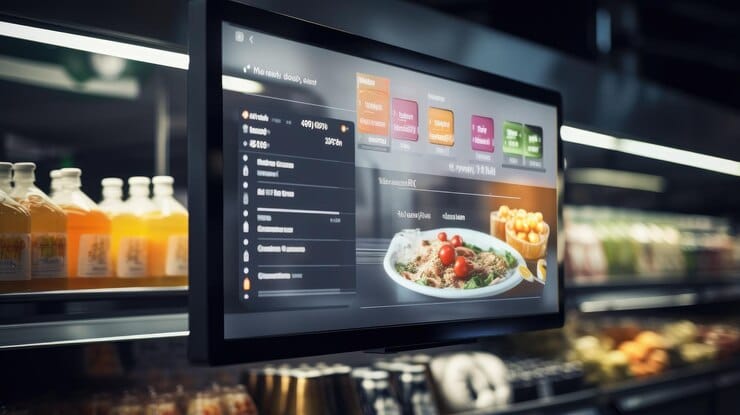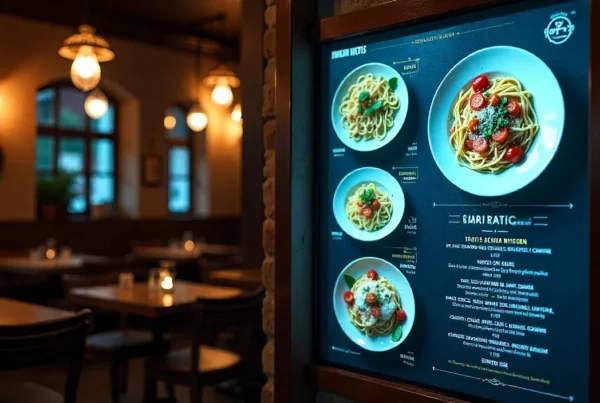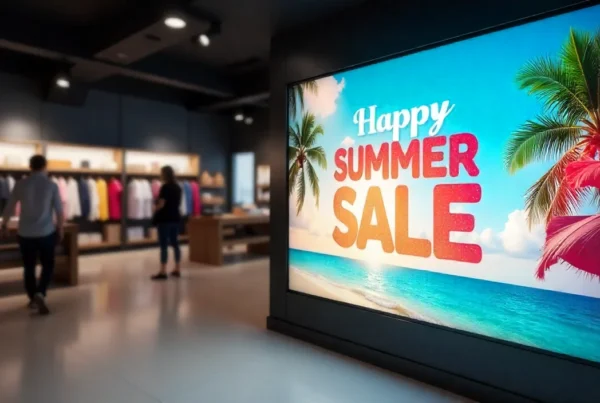Technology is leading the pack of innovation in the massive transformation that the restaurant industry is undergoing. For businesses looking to improve the efficiency and aesthetic value of the dining experience, Digital Signage and ESL have been two of the major highlights on their improving track. What these innovative solutions provide is they enable restaurants to modernize their operations, automate real-time pricing updates, and create a connecting and customer-pleasing environment.
Digital solutions such as IoT Integration, Cloud-based Content Management, and Real Time Pricing updates have streamlined the process and moved the restaurants to be more adaptive to the changing demands of the market. From a quick service restaurant to a high-end dining establishment, Digital Signage and Electronic Shelf Labels (ESL) complement each other to every advantage to better communication, cost savings, and operational efficiency.
How Digital Signage is Transforming Restaurant Operations
Digital Signage is the term for digital display screens found in restaurants to display menus, promotions, and other customer information. This is unlike traditional printed signage, where these updates are done manually. For restaurants, this becomes very inconvenient since they can’t make real-time replacements to the pricing, menu items, or limited-time offers.
Typical Applications for Digital Signage in Restaurants
Menu Boards: Display dynamic menus that change according to the time or based on ingredient availability in the Menu Boards.
Promotional Displays: Promote special offers and encourage upselling through the loyalty program and combo deals.
Wayfinding & Self-Ordering Kiosks: These kiosks help customers navigate the restaurant and place orders without any assistance.
Social Media Integration: Highlight user-generated content, reviews, or live feeds on platforms such as Instagram and Twitter to improve customers’ engagement.
Key Benefits of Digital Signage
Real-Time Updates: Instantly change content in multiple locations at the same time.
Improved Customer Experience: Engaging visuals and motion graphics make menus more appealing and improve Customer Experience.
Centralized Management: Easy to manage the content from a single platform and keep synchronization among the chains of the restaurant.
Cost Savings: Stop spending on printing and labor for changing signage.
Restaurants that use Digital Signage are able to provide entertaining and informative experiences with operations at the same time.
What Are Electronic Shelf Labels (ESL) and How Do They Work?

Although Digital Signage works with larger screens, Electronic Shelf Labels (ESL) are digital price labels that permit restaurants to show current pricing and product information about each object. Unlike static labels, ESLs can be refreshed instantly so that they always match what is displayed on the menu board, ordering system, and physical price tag.
How ESLs Are Used in Restaurants
Real-Time Price Updates: Charge the actual costs or the actual prices of the promotions in real-time.
Nutritional Information: Display key nutrition values to help people take control of their health.
Seamless Integration with POS Systems: Ensure price consistency between digital menus and checkout systems.
Efficient Operation: The ESL’s e-ink technology draws very little power and lasts years on a battery.
Why Restaurants Are Adopting ESL
Increased Pricing Accuracy: Eliminate errors due to manual price updates and gain increased Pricing Accuracy.
Improved Efficiency: Automate the process of price and menu changes to save staff workload.
Better Customer Transparency: Informing customers of up-to-date information on their orders at the checkout.
Eco-friendly Alternative: Reduce paper waste and forever save on the cost of continuous printing of price tags.
In conjunction with Digital Signage, ESLs make it a much more streamlined experience for all parties, such as staff and customers, knowing that all pricing and promotions are accurate, consistent, and engaging.
How do Digital Signage and ESL Work Together?
When combined into a synchronized ecosystem, Digital Signage and ESL can maximize their true power by increasing operational efficiency and service quality. By integrating these two technologies, restaurants can remove pricing blunders, automatically update menus, and establish a smooth substitution for the digital world that will captivate customers.
Benefits of Integrating Digital Signage with ESL
Unified Content Management: Maintain consistent information across menu boards, shelf labels, and promotional screens.
Real-Time Menu Updates: Adjust pricing, item availability, and special promotions instantly.
Increased Automation: Fewer manual tasks to carry out so that the staff spend more time on customer service.
Multi-Location Synchronization: Ensure that the pricing, promotions, etc., in each restaurant location are always up to date.
This integration helps restaurants offer more accurate and up-to-date information to customers, and businesses operate more efficiently and maximize their profits.
IoT Integration: Enhancing Smart Restaurant Operations

In Digital Signage and ESL, the Internet of Things (IoT) plays a large part in automating and making smart decisions via connected devices. Based on the current state of possible IoT use in the food industry, restaurants can take advantage of data-driven insight, predictive analysis, and remote monitoring through IoT technology.
How IoT Enhances Digital Signage and ESL
Automated Price Adjustments: IoT-powered systems can adjust prices according to the trends of supply chain fluctuation, peak hours, and demand.
AI-Powered Recommendations: Smart menus can offer AI-based recommendations to suggest add-ons or promotions based on customer preferences.
Remote Content Control: Restaurant managers can update menus, promotions, and product pricing from anywhere.
Inventory Management Integration: Digital Signage and ESL can integrate with inventory systems so that only in-stock items are displayed.
Using IoT based automation, restaurants will become better equipped to operate in an efficient way; improve customer satisfaction; and decrease labor-intensive tasks.
Cloud-Based Content Management for Restaurants

Running multiple Digital Signage and ESL locations can be a challenge to run manually. Cloud Based Content Management has the solution to this; Centralized control means that our restaurants can update and manage all their digital displays and pricing labels from one platform.
Why Cloud-Based Solutions Are Essential
Scalability: Easily shell to handle multiple restaurant locations.
Instant Updates: Make pricing, promotions, and menu items change in real-time.
Cost Efficiency: They can reduce the need for on-site IT maintenance and printed materials.
Remote Access: Update digital signage from anywhere on the planet, from any device.
Using Cloud-Based Content Management restaurant owners and managers have complete control of their digital signage ecosystem to ensure consistency and maximum efficiency across all locations.
Real-Time Pricing Updates and Their Impact
The pricing in the restaurant industry is dynamic whereby a restaurant must be able to change their pricing depending on market demand, cost of ingredients, and seasonal promotions. Digital Signage and ESL empower restaurants to make these changes in real time as pricing information gets updated on the fly, eliminating the need for manual intervention.
How Restaurants Dynamically Adjust Pricing
Price Base on Demand: Adjust the price during heavy hours and slow periods to reach a revenue goal.
Ingredient Cost Fluctuations: Reflect real-time ingredient price changes in menu pricing.
Seasonal Specials & Promotions: Easily apply time-sensitive discounts or limited-time offers.
Benefits of Automated Price Adjustments
Maintain Profitability: Make sure that the pricing is competitive while keeping the margin.
Eliminate Pricing Errors: These are updated automatically, so there is no longer any discrepancy between the menu and receipt.
Adapt Quickly to Market Trends: Run promotional campaigns for competitor pricing strategies.
Real-time pricing updates enable restaurants to remain agile and competitive and at the same time guarantee customers always get accurate and latest pricing.
Key Benefits of Digital Signage and ESL in Restaurants
Similarly, integrating Digital Signage together with ESL can be beneficial for restaurants in so many ways such as improving customer experience and reducing operational costs.
1. Enhanced Customer Experience
An aesthetically pleasing menu is engaged and easy to order.
Prices, nutritional information, and allergens can be instantly updated for customers to see.
Self-service is available through interactive screens to reduce waiting times.
2. Increased Sales & Upselling Opportunities
Promotions and combo deals are dynamic in nature and encourage higher spending.
Urgency in limited time offers makes people buy things on impulse.
Based on and purchase history of the user and the trending items.
3. Operational Efficiency & Automation
Fewer manual tasks—no need for physical signage updates.
Synchronization across POS systems, digital displays, and ESLs.
Menus and pricing do not need to be managed by staff, so they may focus on service.
4. Cost reductions on printed materials and labor.
There are fewer expenses related to reprints, installation of signage, and labor.
It improves overall energy efficiency than traditional menu boards.
Digital Signage and ESL allow restaurants to boost engagement, improve operations, and increase revenue in a highly technological cutlery dining place.
Challenges and Considerations
However, it is not without its own set of challenges that restaurants will have to overcome when implementing Digital Signage and ESL.
1. Initial Investment Costs
Hardware expenses for digital displays, shelf labels, and cloud-based software.
It also involves training costs in terms of the training that staff must undergo to adapt to new systems.
Long-term ROI consideration—initial costs vs. operational savings.
2. Technical Learning Curve
Training may be required for staff to use the content management systems and software integration.
IT support may be needed to deal with system downtime or troubleshooting.
3. Security and Data Protection
Pricing, digital signage systems, and other similar systems in the cloud should be protected against cyber threats.
Implementation of data encryption and role-based access should be done.
4. Ensuring Compatibility with Existing POS Systems
All Digital Signage, ESL, and POS software integration needs to be seamless.
An upgrade might be necessary if the POS system is older and does not support real-time updates.
By dealing with these challenges before they become a problem, restaurants can be confident that the process of automating digital solutions will be smooth and sustainable.
Future Trends in Digital Signage and ESL
As technology evolves, Digital Signage and ESL will continue to make new advancements in the restaurant industry in terms of automation and personalization.
1. AI-Driven Personalization & Smart Menus
With the help of AI, restaurant interactions with customers are entirely changing. Menus will be adjusted in real-time as customers behave and order in the past. Customers will be served customized meal suggestions. In restaurants, AI-powered systems will also help optimize upselling opportunities by suggesting complementary items to a customer based on their purchase history. Personalized digital menus allow a restaurant to provide a more captivating and precisely tailored dining experience.
2. Augmented Reality (AR) & Voice-Activated Displays
Restaurant menus are getting augmented in how customers interact with them through Augmented Reality (AR). Customers will be able to find virtual food previews of food on AR-based digital menus and see what they are ordering before they actually do so, which helps them make better decisions and ultimately makes them happier. At the same time, voice-activated ordering screens will also provide a hand–free experience for customers to browse menus and personalize meals without needing to make physical contact with a screen. The application of this innovation is critical in fast-paced and high-volume restaurant situations.
3. Eco-Friendly & Energy-Efficient Digital Signage
Energy-efficient digital signage and ESLs are becoming a top priority for restaurants and, therefore, are being adopted. These digital displays made of ‘green’ materials are becoming more common in restaurants since they are seeking to lower their carbon footprint. ESLs and low-power digital signage solutions are also providing companies with additional ways to save energy while continuing to operate at high-performance levels. With the advancement of green technology, restaurants will negatively impact less of the carbon footprint and more on efficiency.
4. Integration with Mobile Apps & Social Media
Nowadays, digital signage and ESL are integrated into restaurants via mobile apps and social media. Having QR codes on digital signage offers diners the opportunity to scan and access the menu, order their food, sign up for the loyalty program, and more. Digital displays featuring customer reviews, featured promotions, and live social media feeds show the customer’s experience, building restaurants’ online presence and customer interaction. Without such a seamless ability to connect in store experiences to digital engagement, restaurants would be starting to build brand loyalty in a way that they have never done so before.
In the future, AI, automation, and sustainability trends will be present, and those who invest in Digital Signage and ESL today will project themselves ahead of the pack and increase operation efficiency for the long haul.
FAQs About Digital Signage and ESL
What is the difference between digital signage and ESL?
Digital signage is a collection of digital displays used to display menus, promotions, restaurant information, etc. Meanwhile, Electronic Shelf Labels (ESL) are digital price tags that dynamically update pricing, nutritional information, stocks at hand, and so on. Significantly, digital signage boosts customer engagement, while ESL enhances the accuracy of pricing and reduces manual labor.
How does IoT enhance digital signage and ESL?
With respect to the IoT (Internet of Things), digital signage and ESL can be integrated so that information can be exchanged between these devices and inventory systems, POS platforms, and real-time data feeds. This facilitates automated updates, price updates depending on demand, and AI-backed customer recommendations, thus making it very easy for restaurants to run.
Are cloud-based content management systems secure?
Cloud-based content management systems (CMS) are built with security in mind. Restaurant data is protected by encrypted data transfers, role-based access control, and multi-layer security protocols, and leading providers do not allow unauthorized modifications.
Can small restaurants benefit from digital signage and ESL?
Absolutely! Digital signage can be utilized by small restaurants to show menus, specials, and promotions without troublesome reprinting fees. Thanks to ESL, even smaller businesses can automate price updates in real-time without having to intervene manually. Over time, the cost savings and increased efficiency outweigh the initial investment.
What are the future trends in restaurant digital signage?
Some of the future of digital signage and ESL include:
Personalization is powered by AI which means the menus change depending on their choice.
Integration of Augmented Reality (AR), enabling diners to almost preview the meals in a 3D form before ordering.
Digital signage that needs no physical interaction, as it is voice-activated.
Playing focuses on developing eco-friendly, low-power, sustainable digital displays.
Social media integration, displaying user-generated content and live restaurant reviews.
Transform Your Restaurant with Digital Signage and ES
Digital Signage and ESL are being integrated into the restaurant industry to provide a seamless and automated way of managing prices, menus, and promotions. Low-cost operational solutions that increase efficiency and customer engagement are a must for modern restaurants.
By investing in Digital Signage and ESL, you minimize manual tasks, keep the price updates in real-time, and have a continuous brand experience wherever you are present. Soon, the restaurant industry will be taking a great leap towards using AI to drive automation while IoT powers restaurant management, and to be ahead of everyone else, it’s high time now to adopt these technologies.
Upgrade Your Restaurant with Nento Digital Signage
If you are looking for the best time to implement the technology, check out this article. Nento Digital Signage is an all-in-one solution with cloud management, IoT capabilities, and easy integration with ESL. Whether you are a small café or a big restaurant chain, Nento lets you save on costs, attract more customers, and optimize restaurant operations.
🚀 Take your restaurant to the next level! Explore Nento Digital Signage Today





